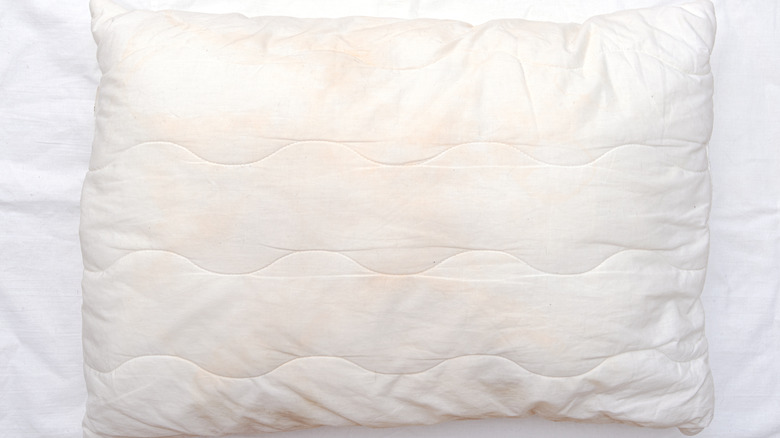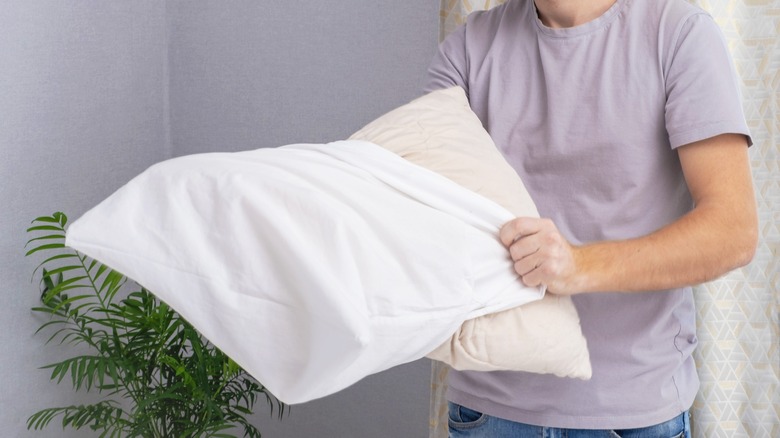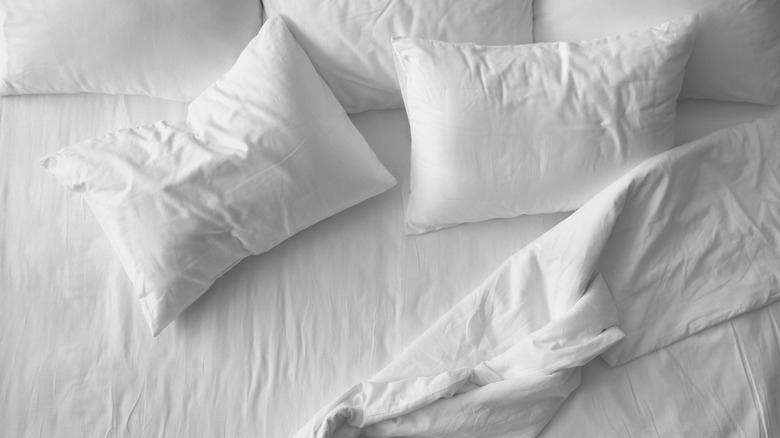The Low-Effort Cleaning Tip That Freshens Up Musty Bed Pillows
We may receive a commission on purchases made from links.
Anyone who has owned a pillow for any length of time knows the all-too-familiar musty smell that can commandeer the fluffy cloud you rest upon. This smell is not only unpleasant; it can also hint at bacteria taking refuge within your beloved pillow, as saliva, dead skin cells, dust mites, pet dander, and mold can accumulate over time. Fortunately, there is a helpful hack that you can easily adopt that will help you freshen, care for, and clean your pillows.
If your pillow has begun to take on a musty smell, now is a great time to embrace the power of essential oils. To begin, remove your pillowcase and pillow protector, adding them to the washing machine along with your pillow, 5 to 10 drops of peppermint essential oil (or another scent, if you prefer), and the correct dose of laundry detergent. After washing your pillow (run it on a double-rinse cycle to remove all detergent), sprinkle 5 to 10 more drops of essential oil on some wool dryer balls (if you don't have any, you can pick up a bag for $7 from Amazon), and throw your pillow and its accessories into the dryer until it is completely dry. Once done, you can place the pillow protector and case back on the pillow and get ready for a fresh night's sleep.
How to get the best results
While this hack is an excellent way to clean your musty pillows, not all types of pillows will be up to the process. Solid or shredded memory foam pillows can become mangled inside the washing machine and are not designed to get wet. These pillows will likely not fully dry, leading to new problems associated with residual moisture inside the foam; the same goes for buckwheat pillows, whose cover is the only portion you should wash. Cotton, polyester fiber-filled, and feather pillows, as well as wool and microbead pillows, are generally able to be washed in the washing machine cool or warm, but all should utilize a gentle cycle to avoid harming the pillow. However, remember to check the label before chucking it into your laundry machines and use the proper method for washing your bed pillows.
If you're struggling to get your pillow completely dry, setting it out in the sun can help evaporate the extra moisture (and add a little more sanitizing oomph to the process). Another important consideration when washing your pillows is the well-being of your washing machine. Uneven and heavy loads can put top-loading machines off-kilter, so remember to balance your load. You can do this by putting two pillows in the machine, one on either side of the washtub, or, if you are only washing one pillow, adding a towel or blanket to the other side.
Do you really need to wash your pillow?
Bacteria buildup is a very real thing, and pillows suffer heavily from this wear and tear, thanks to the indispensable role they play every night. Pillows are subjected to oil from your skin, dead skin cells, drool, dust mites, and the like, all leading to significant bacteria growth. Since they are put through so much, pillows should be washed every 3 to 6 months, depending on your individual makeup (heavy sweaters or those who drool a lot at night should wash their pillows more often).
Cleaning your pillows regularly and with essential oil will do wonders, but most pillows will not last more than five years. This can be somewhat concerning for individuals who have used their pillow for a decade, but it's true; most pillows should be replaced every one to two years with higher-end pillows (or those used in tandem with a regularly washed pillow protector) potentially lasting longer. If you cannot get the musty smell out or your pillow no longer retains its shape, now is the time to get a new one rather than try to revive it. When picking out a new pillow for your bed, remember to do your research and take your sleep preferences into consideration. With any luck, you'll have a couple of years together.


